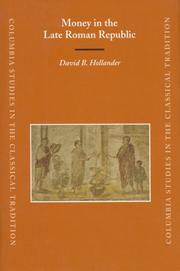| Listing 1 - 1 of 1 |
Sort by
|

ISSN: 01661302 ISBN: 9789004156494 9004156496 9786611921033 1281921033 904741912X Year: 2007 Volume: 29 Publisher: Leiden Brill
Abstract | Keywords | Export | Availability | Bookmark
 Loading...
Loading...Choose an application
- Reference Manager
- EndNote
- RefWorks (Direct export to RefWorks)
Roman monetary history has tended to focus on the study of Roman coinage but other assets regularly functioned as, or in place of, money. This book places coinage in its broader monetary context by also examining the role of bullion, financial instruments, and commodities such as grain and wine in making payments, facilitating exchange, measuring value and storing wealth. The use of such assets reduced the demand for coinage in some sectors of the economy and is a crucial factor in determining the impact of the large increase in the coin supply during the last century of the Republic. Money demand theory suggests that increased coin production led to further monetization, not per capita economic growth.
Money. Monetary policy --- Roman history --- Money --- Coinage --- Monetary policy --- Monnaie --- Politique monétaire --- History. --- Histoire --- Frappe --- Rome --- Economic conditions. --- Conditions économiques --- History --- Economic conditions --- Coinage -- Rome -- History. --- Monetary policy -- Rome -- History . --- Money -- Rome -- History. --- Rome -- Economic conditions. --- Finance --- Business & Economics --- Politique monétaire --- Conditions économiques --- Monetary management --- Economic policy --- Currency boards --- Money supply --- Geld. --- Monetaire politiek. --- Munten. --- Romeinse rijk. --- Civilisation gréco-romaine. (Collection) --- Antieke cultuur. (Reeks) --- Money - Rome - History --- Coinage - Rome - History --- Monetary policy - Rome - History --- Rome - Economic conditions
| Listing 1 - 1 of 1 |
Sort by
|

 Search
Search Feedback
Feedback About UniCat
About UniCat  Help
Help News
News